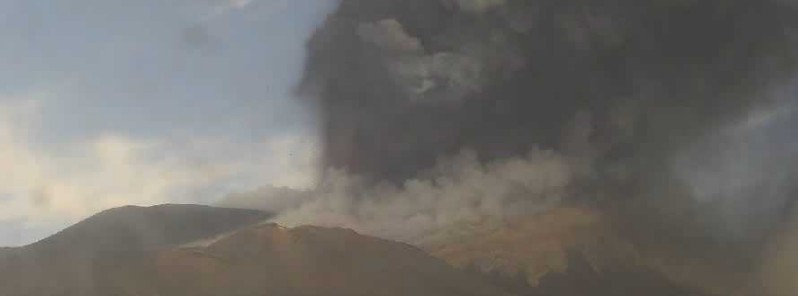Eruption at Etna volcano ejects ash up to 9 km (29 500 feet) a.s.l., Italy

Heavy ash emissions were observed at Etna's Southeast crater since 06:15 UTC on September 21, 2021, where strombolian activity resumed at 06:55 UTC. The Aviation Color Code was raised to Red at 07:10 UTC and lowered back to Orange at 09:30.
Strombolian activity evolved into lava fountains at around 07:55 UTC, with eruptive cloud reaching an altitude of about 9 km (29 500 feet) a.s.l., drifting ENE.
The activity is producing a modest lava flow heading to the southwest.1




Buongiorno a tutti #Etna pic.twitter.com/L8MtSXiuHa
— M Λ X F Ξ R (@maXfer75) September 21, 2021
Etna, imponente colonna di fumo: raggiunta altezza di 9000 metri #eruzione #Etna pic.twitter.com/pXHS8fnbuv
— Local Team (@localteamtv) September 21, 2021
Eruptive events that took place this year at Etna have accumulated significant amounts of pyroclastic material and lava layers on the cone of the Southeast Crater – the youngest and most active of the four summit craters of Etna, leading to a significant transformation of the shape of the volcano and growing the volcano to a record height.2
Thanks to the analysis and processing of satellite images, the Southeast Crater reached 3 357 m (11 014 feet) and is now far taller than its 'older brother' – the Northeast Crater, an undisputed summit of Etna for 40 years.
The summit of Etna, since 1980, has always been considered the Northeast Crater that reached a maximum height of 3 350 m (10 990 feet) with the paroxysms of September 1980 and February 1981.
This height decreased over the years due to the collapses in the summer of 2018 and it settled at 3 326 m (10 912 feet).
Geological summary
Mount Etna, towering above Catania, Sicily's second-largest city, has one of the world's longest documented records of historical volcanism, dating back to 1500 BCE.
Historical lava flows of basaltic composition cover much of the surface of this massive volcano, whose edifice is the highest and most voluminous in Italy.
The Mongibello stratovolcano, truncated by several small calderas, was constructed during the late Pleistocene and Holocene over an older shield volcano. The most prominent morphological feature of Etna is the Valle del Bove, a 5 x 10 km (5.1 x 6.2 miles) horseshoe-shaped caldera open to the east.
Two styles of eruptive activity typically occur at Etna. Persistent explosive eruptions, sometimes with minor lava emissions, take place from one or more of the three prominent summit craters, the Central Crater, NE Crater, and SE Crater (the latter formed in 1978).
Flank vents, typically with higher effusion rates, are less frequently active and originate from fissures that open progressively downward from near the summit (usually accompanied by strombolian eruptions at the upper end).
Cinder cones are commonly constructed over the vents of lower-flank lava flows. Lava flows extend to the foot of the volcano on all sides and have reached the sea over a broad area on the SE flank.3
References:
1 Comunicato Etna [Aggiornamento n. 500] – INGV
2 Etna grows to record height of 3 357 m (11 014 feet), Italy – The Watchers
3 Etna – Geological summary – GVP
Featured image credit: INGV

Commenting rules and guidelines
We value the thoughts and opinions of our readers and welcome healthy discussions on our website. In order to maintain a respectful and positive community, we ask that all commenters follow these rules.